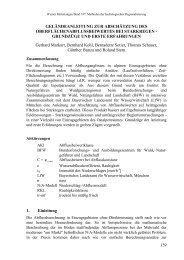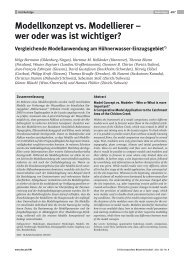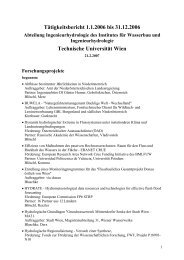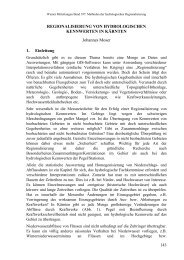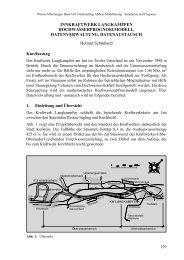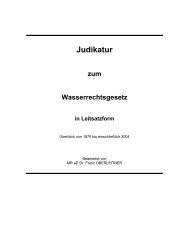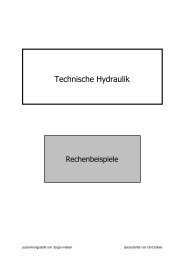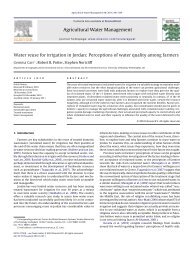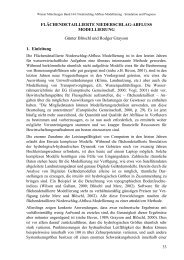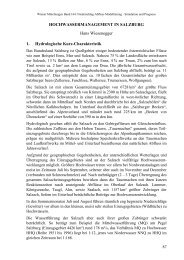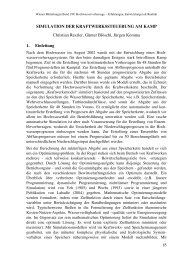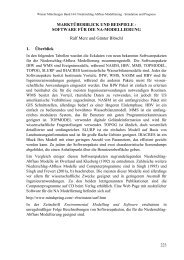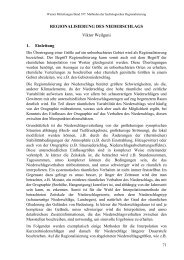Summary of Pattern Comparison and Concluding Remarks
Summary of Pattern Comparison and Concluding Remarks
Summary of Pattern Comparison and Concluding Remarks
You also want an ePaper? Increase the reach of your titles
YUMPU automatically turns print PDFs into web optimized ePapers that Google loves.
362 R Grayson <strong>and</strong> G Blo¨ schl<br />
this book have scrutinised the reliability <strong>of</strong> soils data <strong>and</strong> their effect on the<br />
representation <strong>of</strong> catchment response. For Walnut Gulch (Chapter 6), where<br />
the infiltration excess run<strong>of</strong>f mechanism dominates, TOPLATS was used to<br />
simulate scenarios <strong>of</strong> soil moisture patterns. One <strong>of</strong> the scenarios was based on<br />
uniform soil hydraulic properties, while the other scenario used pedotransfer<br />
functions from the literature to estimate the soil hydraulic properties from<br />
mapped soil type. A comparison <strong>of</strong> the soil moisture patterns from the two<br />
scenarios with observed soil moisture patterns from airborne PBMR, indicated<br />
that the one based on soil type was too patchy <strong>and</strong> the scenario using uniform<br />
soil properties was more consistent with the observations. At Tarrawarra<br />
(Chapter 9) one scenario used soil type to spatially distribute hydraulic conductivity<br />
measurements, assuming uniform conductivity within each soil type zone.<br />
This scenario produced artificially high soil moisture values at the interface <strong>of</strong> the<br />
soil types that could be identified by comparisons with observed soil moisture<br />
patterns. A similar comparison at La Cuenca (Chapter 10) indicated that the<br />
assumption <strong>of</strong> uniform conductivity in each <strong>of</strong> their three l<strong>and</strong> types was not<br />
appropriate <strong>and</strong> a r<strong>and</strong>om component had to be added to the deterministic<br />
pattern imposed by l<strong>and</strong> type. Clearly, the variability <strong>of</strong> soil physical properties<br />
within soil types can be as large or larger than the variability between soil types.<br />
This suggests that the widespread practice in distributed modelling <strong>of</strong> allocating<br />
soil hydraulic properties on the basis <strong>of</strong> soils type (using either pedo-transfer<br />
functions or typical measurements from each soil) is likely to result in poor<br />
simulations <strong>of</strong> patterns in soil moisture <strong>and</strong> run<strong>of</strong>f.<br />
With respect to data issues, the case studies have highlighted the value <strong>of</strong><br />
complementary data (spatial patterns <strong>and</strong> time series), the utility <strong>of</strong> binary patterns<br />
(which are <strong>of</strong>ten simple to collect compared to quantitative patterns) <strong>and</strong><br />
some particular problems in representing soil properties in models. We next<br />
address the utility <strong>of</strong> these data for informing model development.<br />
Modelling<br />
An important reason for comparing simulated <strong>and</strong> observed patterns was to<br />
assess the credibility <strong>of</strong> the distributed catchment models, i.e. how well can they<br />
represent individual processes that operate in the catchment, <strong>and</strong> which processes<br />
are perhaps not represented very well? This assessment resulted in suggestions for<br />
changes in model structure or model parameters (or perhaps inputs) that are<br />
needed to refine the model simulations.<br />
Most <strong>of</strong> the chapters in this book concluded that the models worked quite<br />
well, albeit after calibration, <strong>and</strong> that the main processes were very well represented.<br />
However, they also concluded that it is possible to use subtle differences<br />
between simulated <strong>and</strong> observed patterns to inform us about how the models<br />
could be improved. At Ku¨ htai (Chapter 7), for example, the comparison <strong>of</strong> snow<br />
cover patterns suggested that the model underestimated snow water equivalent in<br />
cirques. This was traced back to not representing emitted radiation from surrounding<br />
terrain. Similarly, a tendency to overestimate (<strong>and</strong> underestimate) snow<br />
cover on south facing (<strong>and</strong> north facing) slopes, was interpreted as evidence that



